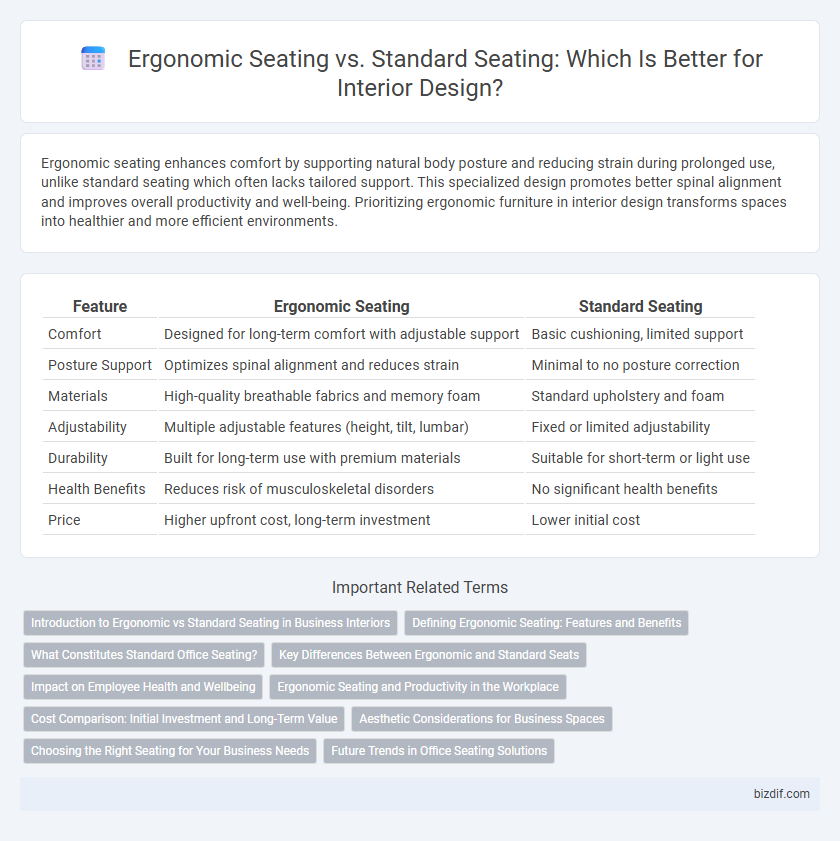Ergonomic seating enhances comfort by supporting natural body posture and reducing strain during prolonged use, unlike standard seating which often lacks tailored support. This specialized design promotes better spinal alignment and improves overall productivity and well-being. Prioritizing ergonomic furniture in interior design transforms spaces into healthier and more efficient environments.
Table of Comparison
| Feature | Ergonomic Seating | Standard Seating |
|---|---|---|
| Comfort | Designed for long-term comfort with adjustable support | Basic cushioning, limited support |
| Posture Support | Optimizes spinal alignment and reduces strain | Minimal to no posture correction |
| Materials | High-quality breathable fabrics and memory foam | Standard upholstery and foam |
| Adjustability | Multiple adjustable features (height, tilt, lumbar) | Fixed or limited adjustability |
| Durability | Built for long-term use with premium materials | Suitable for short-term or light use |
| Health Benefits | Reduces risk of musculoskeletal disorders | No significant health benefits |
| Price | Higher upfront cost, long-term investment | Lower initial cost |
Introduction to Ergonomic vs Standard Seating in Business Interiors
Ergonomic seating in business interiors is specifically designed to support natural body posture, reduce discomfort, and enhance productivity by minimizing strain during prolonged sitting. Standard seating typically focuses on basic functionality and aesthetics without specialized support, often leading to increased fatigue and potential health issues. Incorporating ergonomic seating can improve employee well-being and efficiency, making it a valuable investment for modern office environments.
Defining Ergonomic Seating: Features and Benefits
Ergonomic seating is designed to support the natural posture of the body, reducing strain on the spine and promoting comfort through adjustable lumbar support, seat height, and armrests. Key features include contoured cushions, breathable materials, and dynamic backrests that adapt to movement, enhancing productivity and reducing fatigue. Compared to standard seating, ergonomic chairs significantly improve health outcomes by preventing musculoskeletal disorders and encouraging proper alignment during prolonged use.
What Constitutes Standard Office Seating?
Standard office seating typically features basic adjustability options such as height adjustment and limited lumbar support, with fixed armrests and a cushioned seat for general comfort. These chairs often prioritize affordability and durability over advanced ergonomics, which can lead to discomfort during prolonged use. Unlike ergonomic seating designed to promote optimal posture and reduce strain, standard seating may lack customizable features that accommodate diverse body types and work habits.
Key Differences Between Ergonomic and Standard Seats
Ergonomic seating prioritizes user comfort and health by supporting natural body posture with adjustable features like lumbar support, seat height, and tilt mechanisms, reducing strain during prolonged use. Standard seating typically offers fixed dimensions and minimal support, leading to potential discomfort and poor posture over time. Key differences include the adaptability of ergonomic seats to individual body shapes and movements versus the generic design of standard seats aimed at short-term use or aesthetics.
Impact on Employee Health and Wellbeing
Ergonomic seating significantly reduces the risk of musculoskeletal disorders by promoting proper posture and support, enhancing employee comfort and productivity. In contrast, standard seating often leads to increased physical strain, contributing to fatigue, back pain, and decreased focus throughout the workday. Implementing ergonomic chairs fosters long-term health benefits, reducing absenteeism and improving overall workplace wellbeing.
Ergonomic Seating and Productivity in the Workplace
Ergonomic seating enhances workplace productivity by promoting proper posture, reducing discomfort, and minimizing musculoskeletal strain during long hours of work. These chairs often feature adjustable height, lumbar support, and cushioning that adapts to individual body shapes, fostering better concentration and reducing fatigue. Compared to standard seating, ergonomic solutions significantly decrease the risk of work-related injuries, leading to fewer absences and improved overall employee well-being.
Cost Comparison: Initial Investment and Long-Term Value
Ergonomic seating typically requires a higher initial investment compared to standard seating due to advanced materials and adjustable features designed to enhance comfort and posture. Over time, ergonomic chairs can reduce healthcare costs and increase productivity, offering greater long-term value through improved employee well-being and decreased absenteeism. Standard seating may be more budget-friendly upfront but lacks the durability and health benefits that contribute to sustained cost savings in office environments.
Aesthetic Considerations for Business Spaces
Ergonomic seating in business spaces enhances aesthetic appeal by combining sleek, modern design with functionality, promoting a professional and inviting atmosphere. Unlike standard seating, ergonomic chairs feature adjustable components and tailored support, creating a visually dynamic environment that conveys attention to employee well-being and innovative workplace culture. Integrating ergonomic furniture supports brand identity while maintaining a cohesive design scheme that prioritizes both comfort and style.
Choosing the Right Seating for Your Business Needs
Ergonomic seating enhances employee comfort and productivity by supporting natural posture and reducing strain, making it ideal for businesses prioritizing health and efficiency. Standard seating, while often more cost-effective, may lack adjustable features necessary to prevent discomfort during prolonged use. Selecting the right seating depends on the specific work environment, duration of use, and budget constraints to balance functionality and well-being.
Future Trends in Office Seating Solutions
Ergonomic seating is evolving with smart materials and adaptive designs that promote posture health and reduce workplace injuries, distinguishing it from standard seating focused primarily on basic comfort. Incorporation of AI technology and customizable support systems in future office seating solutions will enhance employee productivity and well-being. Sustainability trends favor eco-friendly materials and modular components, making ergonomic seating an integral part of next-generation office environments.
Ergonomic seating vs Standard seating Infographic

 bizdif.com
bizdif.com